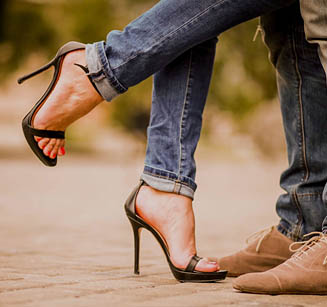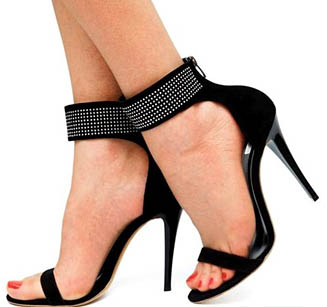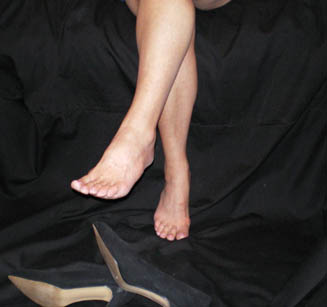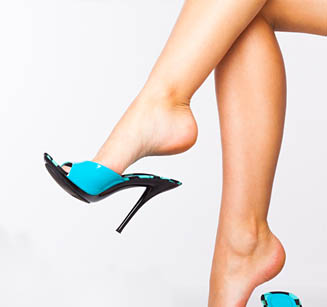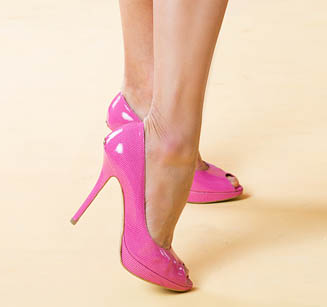Female Shoe Signals
It is estimated that women worldwide spend more than $43 billion on fashion-related footwear per annum. It could be much more! A pair of Manolo Blahniks (made famous by the TV sitcom ‘Sex in the City’) can easily cost more than $500 a pair (2007). A one-off pair of designer Gucci Shoes is even more and may reach $6,000 or higher. ‘Celebrity Only – Hand-made’ shoes by London designer Jimmy Choo are alleged to be priced by negotiation only. A pair of regular retail boots sell for more than $800. The 43 billion dollar question is why? The answer lies in sexual attraction.
“US footwear, apparel brands and retailers continued to turn to imports to supply America’s seemingly insatiable appetite for shoes.” (American Apparel and Footwear Association 2007)
THE SASSY SAILOR
This pose was a favourite of Marilyn Monroe and was made instantly recognisable by a World War Two recruiting poster that showed a women dressed as a sailor with her legs and feet positioned as shown in the image. The caption read: “Hey Sailor – Are you man enough to Join the Navy?” The appeal of this posture lies in the fact that it indicates to a man that the woman has been “unbalanced” by his attention. It makes her legs look longer and shows off her ankles. More erotically, it presses her thighs together and accentuates the curves of her body.
THE KICK BACK / HEEL LIFT
When a woman rests her hands on a man’s shoulders or neck and then raises one leg as shown in the picture then be sure that it’s going to get seriously hot. Psycho-babble claims that it allows the woman to feel slightly unbalanced but the truth is that this body language gesture remains something of a mystery. Still, it is a very common signal and often done when a women kisses a man. Movie producers love this gesture and so do men. In a sense the urgency and passion of the moment is literally lifting the women off her feet. A “come-on” variation of this gesture is the “Flamingo”.
THE ANKLE RUB
When a woman uses one foot to rub the ankle of her other leg – as shown in the picture – she has either just been bitten by an insect or is feeling aroused and attracted by a man that she is with. For the signal to be truly representative of her feelings, the foot should be moving slowly up and down the ankle. It works best when sitting and the legs are relaxed but is not uncommon when a woman is standing by a bar and has already engaged in an interaction with a nearby man. As a signal it indicates a desire to be touched and allows the woman to draw attention to her legs.
THE TOE TIP TAP
This signal generally indicates sincere sexual interest. If the context is non-sexual and the toe is tapped it can indicate irritation. However, in the context indicated in the image to the left it is suggesting attraction. The foot with the raised heel is slid across the floor and the woman’s body leans forward. It is a precursor to the “kiss me” position and accentuates the length of her legs, her femininity and desire. Woman adopting this stance when they are clearly on their own are definitely indicating their desire to be approached. It’s a suggestion of things to come.
ENTWINED
When a woman crosses her legs and then slips her one foot behind her ankle thus locking her legs, , she is either saying “I’m on the defensive’” or she is using the tension of her thighs to put pressure on her vagina. It’s a little know fact that many women can use this position to stimulate themselves to orgasm. Some psychologists believe that “entwined” legs indicate the woman’s desire to become entwined with the man with whom she is communicating. If the legs are positioned forward then this is a positive signal but if the legs are tucked backwards then this indicates reluctance.
FOOTLOOSE / THE SHOE DROP
This is the most significant of shoe related sex signals. By dropping her shoes a woman is saying “OK, I’m ready. My clothes are literally falling off me.” It is also a safe sexual signal and should the woman suddenly feel threatened, she can easily pull back – after all, she only removed her shoes. Of course she may have removed them because her feet were simply too hot. Both men and women are very aware of their feet and that not all feet are attractive. Context is important and if a person is too dumb to realise the difference they don’t deserve to pass on their genes.
THE SHOE DANGLE
This is a strong but subtle message to a man. Translated it says: “By half slipping off my shoe I’m indicating that I am relaxed, comfortable and may be willing to undress further.” It is particularly powerful when the toes are flexed thus moving the shoe to attract attention. This is a precursor to the “kicked free” signal where the shoes are removed completely. Why is this such a strong signal? Well, for many men (even those that won’t admit it), the female foot is (strangely) attractive. Women worldwide spend Billions of Dollars on footwear and pedicures and they do it for a reason!
THE FLAMINGO
It is an aggressive stance that is more commonly associated with men. It implies a “tough” confident approach that says “come on if you’re man enough”. It is particularly relevant if the woman using it is wearing a short skirt and heels as it then reveals her thigh and potentially her underwear. If done in trousers then it may simply imply her projection of a “tough girl” appearance. Either way this is an assertive signal that implies that the woman should be “approached” if the person feels that they are confident enough to do so. This is a favourite of street prostitutes.
THE KNEE TREMBLER
Men who have lived with a woman in an intimate way will recognise this stance. When women remove their underwear they often bring both their knees and feet together in the way shown in the picture above. When a woman assumes this position in a public place it indicates two things. By adopting this slightly awkward stance she is projecting submissive vulnerability as well as a subconscious readiness to remove her panties. It is more commonly seen in television shows than in real-life where woman are increasingly aggressive and assertive in their use of body language.
THE SEXY HOUSEWIFE
This is a strong but subtle message to a man. Translated it says: “By half slipping off my shoe I’m indicating that I am relaxed, comfortable and may be willing to undress further.” It is particularly powerful when the toes are flexed thus moving the shoe to attract attention. This is a precursor to the “kicked free” signal where the shoes are removed completely. Why is this such a strong signal? Well, for many men (even those that won’t admit it), the female foot is (strangely) attractive. Women worldwide spend Billions of Dollars on footwear and pedicures and they do it for a reason!
Continued from top of page …
Facial expressions are the foundations of body language. Some are instinctive and some are learned by watching others and then mimicking them. It’s a fact that children see the gestures used by their parents and copy them as natural behaviour.
As usual, scientists and researchers disagree on the exact number of basic facial expressions. Charles Darwin is recognised as publishing the first serious scientific study in 1872 and in his work “the Expression of Emotions in Man and Animals” he claims to have identified 13 that can be considered universal. These are: astonishment, shame, fear, horror, pride, hatred, wrath, love, joy, guilt, anxiety, shyness, and modesty.
It’s worth noting that many other people before Darwin appreciated the importance of facial expressions and their link to human emotions.
“Beauty without expression is boring.”
This was proposed by Ralph Waldo Emerson an American Poet, Lecturer and Essayist who lived between 1803-1882.
“Sweet babe, in thy face soft desires I can trace, secret joys and secret smiles, little pretty infant wiles” (From the poem Sleep! Sleep! Beauty Bright) This was written by William Blake an English visionary, Mystic, Poet, Painter and Engraver who lived between 1757-1827. He clearly understood the importance of facial expressions.



